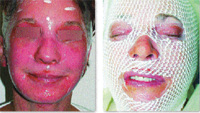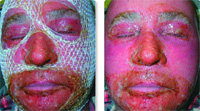Richmond, Va. -
Because a clean, moist environment is important for optimum
wound care, prevention of infection, and hastening of
re-epithelialization, the Silon-TSR membrane placed directly
on facial skin after laser resurfacing fosters healing with
significant reduction of post-operative pain in many cases,
according to Joseph Niamtu III, D.M.D., an oral and
maxillofacial and cosmetic facial surgeon in private practice
here.

Dr.
Niamtu
|
Silon-TSR (Bio Med Sciences, Inc.)
is a transparent, silicone-based wound dressing that is
marketed as a temporary skin replacement. Although it is
non-adherent and can be repositioned, it clings easily to the
wound surface. The dressing allows oxygen influx but is
resistant to water, creating a moist environment to promote
wound healing but allowing water vapor and CO2 to leave the
wound. The transparent nature of the dressing allows the
surgeon to visualize the wound to assess healing.
Silon biopolymer
After the laser resurfacing
procedure, Dr. Niamtu applies the Silon biopolymer and retains
it with a tube gauze net bandage (Surgilast Tubular Elastic
Dressing Retainer, Western Medical, Ltd.). The lasered
surfaces not covered by the Silon are coated with Elta Renew,
a melting petrolatum product (Medwing, Inc.).

After
the laser resurfacing procedure, Dr. Niamtu applies the
Silon biopolymer and retains it with a tube gauze net
bandage (Surgilast Tubular Elastic Dressing Retainer,
Western Medical, Ltd.). Photographs courtesy of Joseph
Niamtu III, D.M.D.
|
"Intolerable pain is extremely rare
with this type of membrane, and in many cases patients do not
even require post-operative analgesics," Dr. Niamtu says.
Although many practitioners leave the Silon in place for up to
five days, Dr. Niamtu prefers to remove it at 48 hours and
allow the patients to shower and wash their hair with Cetaphil
Cleanser (Galderma Laboratories). The following day he begins
cleansing the lasered skin with Cetaphil Cleanser. The patient
begins gentle hand washing of the lasered skin every 12 hours.
After the Silon is removed,
the patient uses Elta Renew continuously until day five or
six. The patient is then switched to Elta Light (Medwing), a
cream-based light moisturizer, until re-epithelialization is
complete. For the rare patient who has significant pruritus or
local inflammation, Dr. Niamtu says he may elect to also use
Temovate Ointment (clobetasol propionate 0.05 percent,
GlaxoSmithKline), a topical steroid, for several days to
soothe itching or inflammation. The short-term use of topical
steroids has not caused any significant problems in these
patients.

Lasered skin covered by Silon-TSR
dressing shows a clean, smooth, healthy wound. Note the
difference in healing between areas covered by the Silon
and those that were not protected, which present with
serous crusting, increased debris, and inflammation, Dr.
Niamtu says.
|
Lasered skin covered by Silon-TSR
dressing shows a clean, smooth, healthy wound. "To appreciate
the impact of Silon-TSR on wound healing, note the difference
in healing between the areas that had been covered by the
Silon and those that were not protected," Dr. Niamtu says.
"Areas not covered present with serous crusting, increased
debris and inflammation and pain."
Patient compliance
As with all wound care,
patient compliance is essential. Even the most intelligent and
capable patients can fail to follow the surgeon's instructions
regarding post-operative wound care. With poor patient
compliance, healing problems can arise that affect the final
cosmetic results.
"Serous crusting and dirty
wounds are a prescription for disaster," Dr. Niamtu says. "One
patient presented on the fourth day after laser resurfacing,
having completely disregarded proper wound care. Intense wound
debridement was necessary. Although the final result was not
compromised in this case, this type of wound environment is an
excellent culture medium for bacteria, yeast and viral
infections." CST
Dr. Niamtu reports no
conflicts of interest with any manufacturers named in this
article.